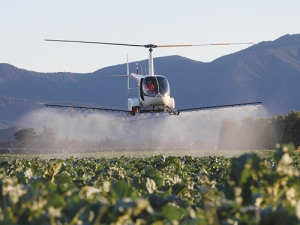The air support is a spray boom-equipped helicopter from Way To Go Heliservices, Rangiora, flown by Matt Cruickshank.
Dairy News joined the team from Way To Go as they mounted an early morning attack on the ravenous caterpillars chewing through the crops.
With dairy farmers facing a tough time, every expense has to be justified and every dollar spent maximised.
Though there is a perception that getting a helicopter is an expensive way of dealing with these pests, in fact it's not true: more and more farmers are turning to the skies to optimise their returns from their crops.
Ricketts says "It's a no brainer to get the choppers in. You spend a lot of effort getting your crop to where it is, so why would you drive over it?"
The non-invasiveness of aerial spraying is a key advantage over ground-based spraying. Ground sprayers and spreaders damage 5-10% of crops; some grain farmers report that up to 12% of crops sustain damage.
Not so with a helicopter, and there's no soil compaction and no risk of disease spreading from other crops as the chopper moves from paddock to paddock. You can therefore use the full growing area of your land whether you own it or lease it.
Aerial spraying allows a larger area to be covered faster, and specific areas and obstacles like centre pivot irrigators present no problem.
Way To Go chief pilot and chief executive Rob Kittow provided figures to show the advantage of aerial work.
Taking a typical fodder beet crop that will generate $6000/ha, if ground spraying damages 5% of a crop, that costs $300/ha.
With an aerial application costing $50/ha, and allowing for four applications per year, the cost is $200/ha. In contrast, a ground application costing $25/ha, for four applications, would cost $100/ha. The difference between aerial and ground appears to be $100/ha in favour of ground operations.
But when you factor in an increased yield due to aerial application not damaging the crop, this shows a $100/ha advantage for the aerial operation.
Other economic advantages of aerial operations, e.g. full utilisation of land, no soil compaction, no disease transfer, no plant damage to upper plants from vehicle undercarriage, at 2.5% that gains another $150/ha.
Therefore a $250 gain per hectare for a 100ha crop gives an increased return of $25,000; a 200ha crop would increase this to $50,000.
Back at Oxford, Kittow's pilot and ground crew work to minimise the aircraft's time sitting on the ground.
The speed of the operation means Cruickshank can complete all Ricketts' and his neighbours' tasks in about two hours then head off to another spray job in the hills above Oxford.
Baydon Phillips saw a major fire rip through his property late last year and has called in Way to Go to nail the weeds that have sprouted all over his land.
Around 30 minutes of flying later the task is over; "job done" Philips remarked with a smile on his face.
Cruickshank showed the skills and the utility of the Robinson R44 he was flying: he selected one spray boom and flew along the top of a deer fence, enabling him to get close to the boundary.
Demand from Mid Canterbury farmers for the Way To Go service has led to Kittow deciding to base a machine near Ashburton.
The results for farmers have been spectacular: potato farmers report crop yield increases of 25%.
Aerial work has traditionally been seen as an option only for steep hill country or hard-access areas. But flat land farmers like Ricketts, looking at every dollar spent and keen to maximise the benefits of that spend, are realising the benefits of having a helicopter do spraying and fertilising operations on their properties.
















